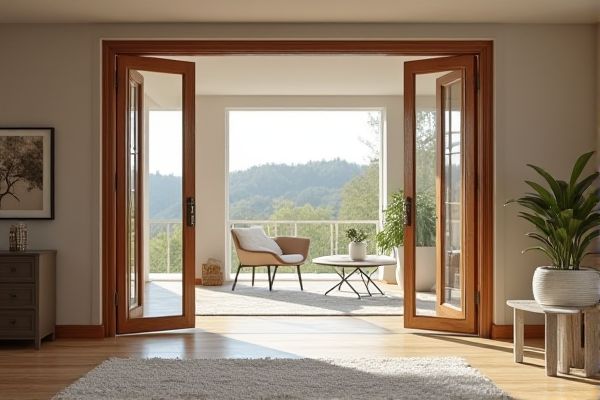
Folding doors and bifold doors both offer space-saving solutions, with folding doors typically referring to a broader category that includes bifold doors, which specifically fold in pairs to open fully and create wide access. Understanding the differences in design, installation, and functionality can help you choose the perfect door system for your space; explore the rest of the article to discover which option suits Your needs best.
Table of Comparison
| Feature | Folding Doors | Bifold Doors |
|---|---|---|
| Design | Panels fold flat against one side. | Panels fold in pairs, stacking compactly. |
| Operation | Single or double side folding mechanism. | Designed to fold in multiple panels on hinges. |
| Space Efficiency | Requires space beside the frame to stack panels. | More compact folding, ideal for limited side space. |
| Installation | Easier to install with simpler track systems. | More complex track and hinge setup. |
| Use Cases | Suitable for wide openings and patios. | Popular for compact rooms and closets. |
| Cost | Usually more affordable. | Typically higher price due to complexity. |
| Material Options | Wood, aluminum, PVC commonly used. | Wood, aluminum framing mostly preferred. |
| Maintenance | Lower maintenance with fewer moving parts. | Requires regular hinge and track care. |
Introduction to Folding Doors and Bifold Doors
Folding doors, also known as accordion doors, consist of multiple panels that fold against each other, creating a wide opening ideal for blending indoor and outdoor spaces. Bifold doors, a specific type of folding door, typically feature two panels per section that fold neatly to one or both sides, maximizing space efficiency and ease of operation. Both door types enhance natural light and ventilation while offering flexible room division in residential and commercial settings.
Design Differences: Folding vs Bifold Mechanisms
Folding doors typically consist of multiple panels connected by hinges that fold back in a concertina style, allowing for a smooth, compact opening. Bifold doors also have hinged panels but are designed to fold in pairs, stacking neatly against each other for a wider, unobstructed passage. Your choice between these mechanisms impacts both the visual appeal and functional space efficiency of your interior or exterior doorway.
Material Options for Folding and Bifold Doors
Folding doors and bifold doors offer diverse material options including aluminum, timber, uPVC, and composite, each providing different levels of durability, insulation, and aesthetic appeal. Aluminum folding doors are prized for their strength and sleek design, while timber bifold doors offer natural warmth and superior insulation. Selecting the right material for your folding or bifold doors ensures optimal performance and complements your property's style.
Space Efficiency: Which Door Saves More Room?
Bifold doors typically save more room than traditional folding doors because they fold into compact panels that stack neatly to one side. Folding doors often require more clearance when opened as they fold in larger sections, occupying additional space. Your choice should consider the door's folding mechanism to maximize usable space in tight areas.
Installation Process: Folding vs Bifold Doors
The installation process for folding doors typically involves mounting tracks both at the top and bottom, requiring precise alignment for smooth operation, while bifold doors are often easier to install due to their hinged panels that fold against each other on a single track. Folding doors demand professional expertise for track placement and panel calibration to prevent binding, whereas bifold doors can be a DIY-friendly option with simpler hardware and fewer alignment complexities. Both types require accurate measurements and sturdy frame preparation, but bifold doors generally offer a more straightforward installation process with quicker setup times.
Aesthetic Appeal and Style Variations
Folding doors offer a sleek, modern aesthetic with clean lines that seamlessly integrate into contemporary spaces, while bifold doors provide a versatile style that combines functionality with a classic, segmented appearance. Both options come in various materials such as aluminum, wood, and uPVC, allowing customization to match architectural themes and interior design preferences. Bifold doors typically create wider opening spans, enhancing indoor-outdoor flow, whereas folding doors emphasize compact stacking for minimal visual obstruction.
Durability and Maintenance Requirements
Folding doors typically feature a robust frame and fewer moving parts, resulting in higher durability and lower maintenance requirements compared to bifold doors, which contain multiple hinges and panels prone to wear and misalignment. Bifold doors require regular lubrication and adjustment to maintain smooth operation and prevent premature damage, especially in high-traffic areas. Choosing folding doors can reduce long-term repair costs and minimize upkeep efforts while ensuring consistent performance.
Security Features: Folding vs Bifold Doors
Folding doors often provide enhanced security with multiple locking points spread across the frame, making unauthorized access more difficult compared to traditional bifold doors. Bifold doors, while stylish and space-saving, typically rely on fewer locks concentrated at central points, which may present vulnerabilities. Your choice between folding and bifold doors should consider the level of security needed for your property alongside design preferences.
Cost Comparison and Value for Money
Folding doors typically cost less upfront than bifold doors due to simpler hardware and fewer panels, making them a budget-friendly choice for many homeowners. Bifold doors, while more expensive, provide greater flexibility and space-saving benefits that enhance their overall value for money in rooms requiring wide access. The long-term durability and energy efficiency of bifold doors can justify the higher initial investment compared to folding doors, especially in high-traffic areas.
Ideal Applications and Usage Scenarios
Folding doors are ideal for creating wide, unobstructed openings in spaces like patios, living rooms, or conference areas, allowing for seamless indoor-outdoor transitions. Bifold doors excel in compact environments such as closets, laundry rooms, or small offices where space-saving and easy access are essential. Your choice depends on the balance between aesthetic appeal, space constraints, and functional requirements specific to the installation area.
 homyna.com
homyna.com